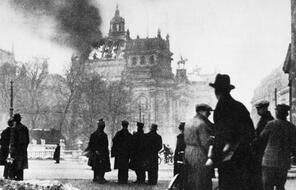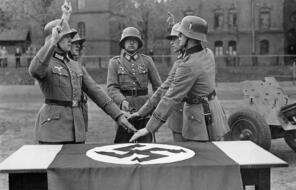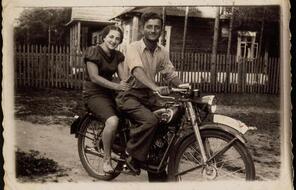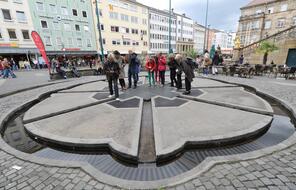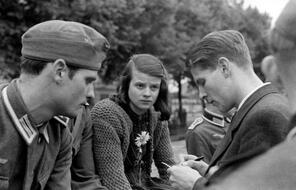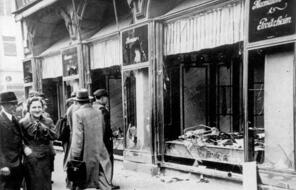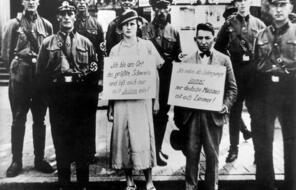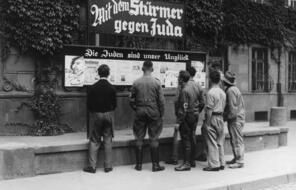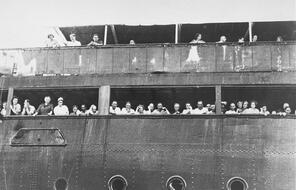A Statement of Faith
At a Glance
Language
English — USSubject
- History
- Social Studies
- The Holocaust
In a television series exploring the nature of creativity, journalist Bill Moyers tells viewers, “It is not a scientifically certifiable fact that each child born into the world comes with the potential to create. It is rather a statement of faith. But I can’t imagine any declaration more important . . . to make. Where our heart is, so too perhaps is our greatest treasure.” The Jews of Terezín struggled to honor that “statement of faith” in a place where young and old alike were dehumanized and routinely humiliated.
In Terezín, the Nazis fostered the illusion that Jews had some measure of authority by creating a “Council of Jewish Elders” to manage the community. In fact, it was the Nazis who ran Terezín. They issued the orders. They made the rules. And they saw to it that those rules were enforced exactly the way they wanted them to be enforced. From the start, they regarded Terezín as a forced labor camp. So they split up families soon after their arrival, housing men, women, and children in separate barracks.
The Council of Jewish Elders used what little authority it had to protect the children. They were given extra food. Special workers—for the most part, former scout leaders—were assigned to their barracks. Although caregivers were not supposed to teach their charges, many of them saw education as their first priority. So did the children. As one teacher recalled:
They started their learning with such energy and enjoyment, that even today it would be worthwhile to write a paper on ‘pedagogical problems in the concentration camp.’ We were able to punish the children, for instance, by temporary exclusion from lessons. School went on in spite of the prohibition against education. One of the pupils was always on guard, and when he noticed danger—the SS men—he whistled, and teaching turned into amusement of the children. We sang and played. That was permitted. 1
In Helga Kinsky-Pollack’s barracks, there was “a parliament, we had an emblem, we had a hymn which we sang, and we had a uniform which we only had on at festivities.” Each girl chose a sign for her bed. Pollack selected a lighthouse because “in the dark sea when everything is dark, only one place shines and helps the people drowning in the water. That is a lighthouse, and I thought it was an emblem of somehow to survive.” 2 Kurt Kotouc also lived in the children’s barracks. He told an interviewer:
Everything that happened to us made us grow up faster, at least psychologically. We had witnessed the destruction of our homes, the helplessness of our parents. Marked by stars and numbers, in quarantine and in the Schleusen [the staging area for transports to Auschwitz], we saw conventions destroyed, and witnessed the ardor and fragility and finiteness of human relationships, we saw altruism and naked selfishness, we listened to the death rattle of the dying and the heavy breathing of couples having sex.
And this was how Valtr Eisinger found us. He was still very young himself, only twenty-nine. He was not a brilliant man, just a talented teacher at the beginning of his career. He hadn’t yet been given the chance to stretch his abilities, to clarify his views of life and the world. He was still busy with himself, and now wanted above all to help us. . . . We loved his enthusiastic courage, his certainty in this fragile world of the camp. . . . We felt close to him, this wonderful teacher who talked to us about the philosophy of Mahatma Gandhi, translated poems, played football, moved into a bunk in our home, sang in The Bartered Bride, and loved his Terezín wife, Vera, with all his heart. We could laugh at his faults, but they only brought him closer to us. The knowledge of our common fate, and Eisinger’s personality, enabled us to establish a community that included orphanage boys as well as the son of a scientist or a self-assured son of a luxury car dealer. 3
With the encouragement of Eisinger and other child-care workers, the boys in Home Number One of L417 [house number 17 on the fourth lengthwise street] created a secret magazine, Vedem. It was published every Friday for nearly two years. The first issue contained a speech by one of the boys, Walter Roth:
The banner has been raised. Home Number One has its own flag, the symbol of its future work and its future communal life. The Home has its own government. Why did we set it up? Because we no longer want to be an accidental group of boys, passively succumbing to the fate meted out to us. We want to create an active, mature society and through work and discipline transform our fate into a joyful, proud reality. They have unjustly uprooted us from the soil that nurtured us, from the work, the joys, and the culture from which our young lives should have drawn strength. They have only one aim in mind— to destroy us, not only physically but mentally and morally as well. Will they succeed? Never! Robbed of the sources of our culture, we shall create new ones. Separated from all that gave us pleasure, we shall build a new and joyously triumphant life! Cut off from a well-ordered society, we shall create a new life together, based on organization, voluntary discipline and mutual trust.
Torn from our people by this terrible evil, we shall not allow our hearts to be hardened by hatred and anger, but today and forever, our highest aim shall be love for our fellow men, and contempt for racial, religious, and nationalist strife. 4
The boys in Home Number One of L417 participated in many of the cultural activities in Terezín. Several had parts in Hans Krasa’s children’s opera. Brundibar is the story of two small children, Pepicek and Anicka, who sing in the streets to raise money for their sick mother.When Brundibar, the wicked organ grinder, tries to stop them, a dog, a cat, and a sparrow come to the children’s aid. So do other boys and girls in the neighborhood. Together they sing a lullaby and people on the street shower them with money. When Brundibar steals their earnings, the children and the animals chase him. The opera ends with their victory. In Vedem, Rudolf Lauf describes what the opera meant to him and the other children.
We arrived an hour and a half before curtain, and when we saw each other in our makeup, which we thought terrible, we began to cut up as usual, till Rudi had to come and settle us down. But as soon as the audience started filing in, our little souls were slowly but surely overcome by stage fright. Three of the “experienced” actors walked up and down backstage and said over and over again: “I haven’t got stage fright, nothing can throw me off,” and only their scarlet ears belied them. But as soon as the first bars of the music sounded, we forgot our fear and went to it. Everything went well. Brundibar . . . on stage with the artisans saw to it that there was a lot of fun, while Pepicek, Anicka, and the animals took care of the musical side of things. And the lullaby sung by the choir: “Mummy is rocking. . .” moved everyone and reaped well-deserved applause. . . . And when we had finished and the hall was filled with thunderous applause, we were all happy and content, for man is a creature eager for fame. And in all of us there was some satisfaction at having done a thing well. . . .
Brundibar will soon disappear from the thoughts of those who watched it in Terezín, but for us actors it will remain one of the few beautiful memories we have of that place. 5
At the end of the opera, the children are supposed to sing, “Who so loves his mother and father and his native land is our friend and may play with us.” But at Terezín, those lines were rewritten. Instead the children sang, “Whoever loves justice and will defend it and is not afraid, is our friend and may play with us.”
Connection Questions
- Teachers like Valtr Eisinger wanted to bring their children “out of the ghetto spiritually” and keep them “mentally sane, so that they would become quite normal people.” What does it mean to bring someone “out of the ghetto spiritually”? What kind of learning is involved in the process? How can music contribute to that effort? What examples do we see of adults trying to “bring their children out of the ghetto and keep them mentally sane” in Michael Gruenbaum’s memoir Somewhere There Is Still a Sun?
- The word vedem means “in the lead.” How appropriate was the name? To what extent did the boys and their magazine live up to the ideals expressed in Walter Roth’s speech? To what extent did Franta and the boys in Room 7 live up to the ideas expressed in Roth's speech?
- The cast gave 55 performances of Brundibar before Krasa, Franek, and the children were placed on a transport to Auschwitz. Rudolf Franek was among the few to survive. He later tried to explain why the opera was so popular with young and old alike:
With what enthusiasm we sang: “Beat your drum, we have won . . . we did not give in! . . . we were not afraid. . . .” Everything could be summed up under the concept of Brundibar. You must face evil. One man alone is helpless. “There must be more of us! The more, the better!” 6
How important is the change in the last lines of the opera? To what extent is the change an act of resistance? What does the opera suggest about the relationship between music and resistance? Between music and society? How is music linked to the issues and circumstances people face today? What part does music play in your life? - Honza Treichlinger, a 14-year-old orphan, played Brundibar, the evil organ grinder in the opera. Rudi Franek later wrote of Treichlinger’s performance:
Honza, quite instinctively, made the character of Brundibar so human that although he played a wicked character, he became the darling of the audience, and not only of the children in the audience. He learned to “twitch the whiskers” which we stuck under his nose. He twitched them so well, and at just the right time, that tension relaxed in the auditorium, and often we could hear the children releasing their bated breath.
From the moment in which he “made” the character, he played all performances without an understudy. Anybody else would have failed.
What might he have become? Actor or engineer? How he could have humanized his own life as he had his role! That he was rather short was fateful to him. He was fourteen years old. He went to Auschwitz with the old and the small children and directly into the gas chamber. 7
How does an actor “humanize” a character? How does a person “humanize his or her life”? - What new, different, or deeper understanding do you have about Brundibar or resistance after reading and discussing this reading?
- 1 Rudolf Franek, “Brundiba,” in Terezín. Council of Jewish Communities in the Czech Lands, 1965, 253.
- 2Quoted Debórah Dwork, Children With a Star (New Haven: Yale University Press, 1991), 128.
- 3We Are Children Just the Same: Vedem, The Secret Magazine by the Boys of Terezín, trans. R. Elizabeth Novak (Jewish Publication Society, 1994). Reproduced with permission.
- 4We Are Children Just the Same: Vedem, The Secret Magazine by the Boys of Terezín, trans. R. Elizabeth Novak (Jewish Publication Society, 1994). Reproduced with permission.
- 5We Are Children Just the Same: Vedem, The Secret Magazine by the Boys of Terezín, trans. R. Elizabeth Novak (Jewish Publication Society, 1994). Reproduced with permission.
- 6We Are Children Just the Same: Vedem, The Secret Magazine by the Boys of Terezín, trans. R. Elizabeth Novak (Jewish Publication Society, 1994). Reproduced with permission.
- 7We Are Children Just the Same: Vedem, The Secret Magazine by the Boys of Terezín, trans. R. Elizabeth Novak (Jewish Publication Society, 1994). Reproduced with permission.
How to Cite This Reading
Facing History & Ourselves, “A Statement of Faith,” last updated June 29, 2018.
This reading contains text not authored by Facing History & Ourselves. See footnotes for source information.

